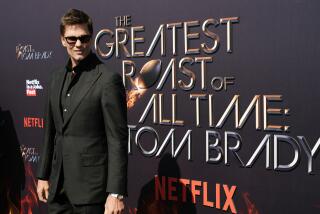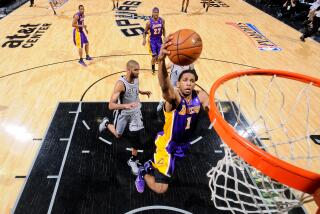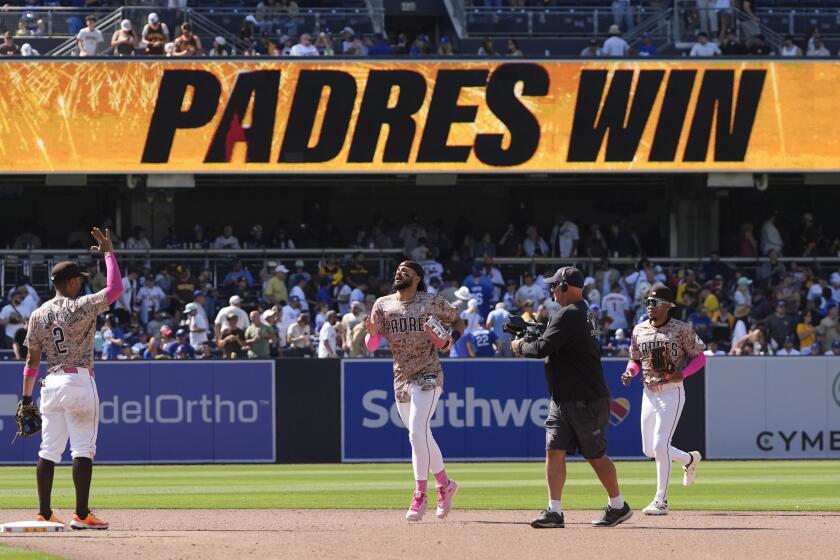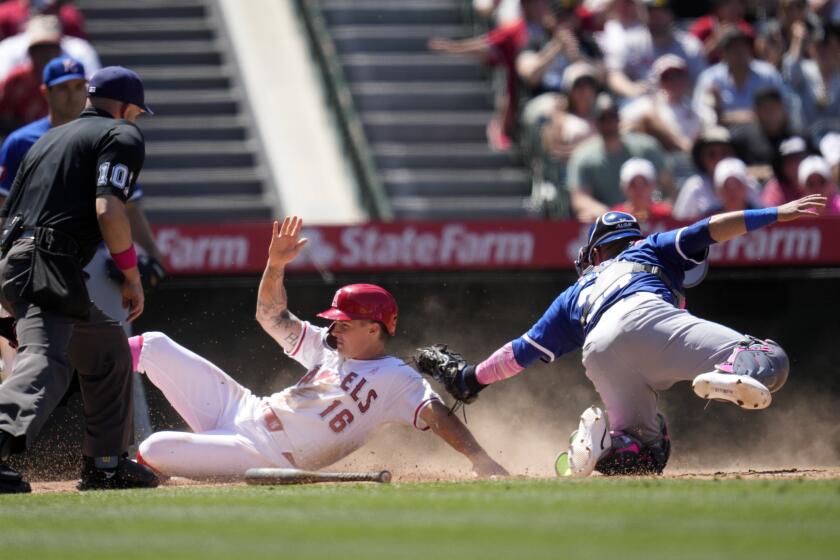Child labor . . . or Laver?
THIVERVAL-GRIGNON, France -- The French visionary finds most human beings almost pitifully oblivious. He sees them ambling through the world while barely noticing the world.
So if you wish to denounce him for accepting a Sacramento tennis phenom with the shocking age of 4 into his tennis academy west of Paris in September 2006, it won’t perturb his pulse.
“I know everything can happen in life,” Patrick Mouratoglou said. “Most people have very closed minds. Has to be like this or like that. So things can come into their view, and they don’t even see it.”
Wavy-haired, 37, suave without trying, Mouratoglou doesn’t hanker to convince. He just knows his phone rang in March 2006, and that on the line was Marcos Baghdatis, the 2006 Australian Open finalist, and an erstwhile Mouratoglou pupil. Baghdatis spoke as if having just seen an extraterrestrial.
“I was on the practice courts at Indian Wells,” Baghdatis began to Mouratoglou, “and while I was practicing, I saw someone who when I saw what he was doing was the first time I ever see something like this.”
Baghdatis had noticed a novelty invitee of the Pacific Life Open, Jan Silva, who’d turned up hitting tennis balls on the news in Sacramento way back at age 3. Mouratoglou, trusting of Baghdatis, reacted as would most any tennis-academy founder with zero concern that others think him eccentric: He bought the tyke and his family airplane tickets to France.
The parents, “Jani” the boy tennis player, his older brother and younger sister flew into Paris in June 2006. They rode westward from Paris, out to a bucolic French village that looks precisely as you’d think a bucolic French village might look, to a tennis academy in front of a cornfield with indoor-court bubbles that look like big white ticks.
Scott Silva, a welfare officer for Sacramento County, and Mari Maattanen-Silva, a tennis instructor at Gold River Racquet Club, had come upon the brainchild of Mouratoglou, who started his academy in the Paris suburbs in 1996.
In his childhood, Mouratoglou had reached 15 as a rare tennis animal who served and volleyed and harbored visions of a far-flung Patrick Rafter, until his magnate father made him shoo the daydreams and veer toward business school.
He slogged and slept through two years of that, worked at his father’s renewable-energies colossus, left his racket untroubled for seven years, but then realized he could still summon peace just by looking at a tennis court.
With his father’s help, he envisioned the biggest tennis academy in Europe and got going, seeing himself as “more American than French in the way I see my job and life,” and believing players can become champions by “thinking the way Americans think.”
Now in June 2006, with his academy and his management business and his locally popular health club on the premises, he found himself hitting balls for about 90 minutes with this, this, this . . . American 4-year-old who would turn 5 that November.
“I played a match from the baseline with a 4-year-old, can you imagine this?” Mouratoglou said. “With a one-handed backhand, at 4. Being able to play a one-handed backhand from the baseline at 4 years old? Good luck to all the others.”
He concluded that even though it was chancy business given the prodigy’s age, he’d merely move the entire Silva family to Thiverval-Grignon if they wished, pay for its expenses, hire Mari as an instructor, have them reside in one of the 19 cabins up on the ridge above the courts, see that they had a car, and enroll their children in the French school down the road.
“It’s impossible for me not to help him,” Mouratoglou said. “Impossible. It would be a scandal. He’s 4, and you give him a violin and it’s just you feel this violin is part of his body. What do you do?”
The Finnish mother and tennis instructor always preferred the grind of the tennis to the attention of the tennis when roosted atop her own country’s rankings and playing for the University of the Pacific. She’s mystified to have a son who’s already all chirpy appearing on “Today” and “The Ellen DeGeneres Show” and for TV camera crews from as far away as Brazil.
So if you wish to criticize Mari because her family sold its house and furniture and two vehicles because of her son’s talent, she knows it’s out there and she stoically steers clear. “Her whole approach to the whole thing is Scandinavian,” her husband said. “They’re just about the work. Let’s just do the work.”
Her water broke while teaching tennis on Nov. 16, 2001, but she held off for 20 more minutes and finished the lesson before fleeing to the hospital. She gave birth the next morning to Jan, her first child and her husband’s second, and the tot turned up immediately at courtside in tennis-ball baskets and such, the tennis village helping raise him.
“He started hitting balls before he could walk,” Mari said, but only in 2003 did she start to notice she’d birthed the creature from Planet Racket.
The uncanny materialized late that summer. It came shortly after she and Scott taped a thoroughly forgettable match between James Blake of the United States and Paradorn Srichaphan of Thailand, the final of the Long Island tuneup for the U.S. Open. As almost nobody on Earth but the participants remembers, Srichaphan led Blake 6-2, 4-0, then held on to win 6-2, 6-4. An entire planet went “Zzzzz,” save for a 21-month-old Californian who was transfixed. He began imitating the shots, hitting balls against a living room wall and, most strikingly, imitating the changeovers.
Jan would stare straight ahead, focusing on the next game, and “drinking the water,” Mari said. “He had his little towel.” This went on for four or five hours a day, and then, she said, “I would wake up in the middle of the night and hear this sound,” then realize that Blake and Srichaphan were playing again.
He could operate the tape player at 2, hit maybe 20 shots from a real baseline at 2, tie his shoes at 3, leading his parents to wonder, What is this? The famed IMG Bollettieri academy in Florida had a look, but the Silvas said they didn’t have the money.
Now In France Jani goes to school in the mornings, then works with his mother on an indoor court for an hour or 90 minutes. She’s still an athlete at 32 as she tosses a little blue football with him back and forth across the net. She answers his barrages of questions and of shots, and finally here it comes, out of the backhand corner, a fluid, effortless one-hander digging out the ball and sending it to the opposing service line.
It seems to violate physics.
This, from a kid so obsessed with Australia’s band and TV show “The Wiggles” that he demanded a guitar. He plays with neighbor children from a Scottish family, who’ve enrolled their son, and he doesn’t know his family relocated because of his tennis.
It’s pretty sanguine, easier for Mari in some ways than revisiting Sacramento, where some friends found the move appalling and cut off ties. “A lot of people think he’s not going to school, he’s just training five hours a day, everybody’s using him,” she said.
She summarized, “You can’t compare Jani to any other child. Because there’s never been another child that’s been in exactly the same situation he is.”
The American father does as many an American male would do -- now that the first wave of publicity has hit and receded since summer, he Googles his son’s name almost daily. In case of erroneous criticisms, he provides staunch defense.
So if you want to criticize him for giving up a job where he met with prospective welfare recipients, Scott Silva, 38, might well post a strident reply.
“I chime in,” he said. “I chime in as soon as it gets crazy and as soon as it gets negative. I say, ‘You don’t get it. You just don’t get it.’ . . . I don’t miss any sleep, but it [angers] me. . . . I guess that’s what goes with this.”
The world has seen its share of lousy tennis parents, so suspicion has become the reflex. Somebody wrote a post claiming he’d visited the Mouratoglou Academy and witnessed Jan Silva training three hours a day, training at 1 a.m., training so much he could neither read nor spell his name.
That one brought a reply from Scott, who says of his son, “By 9 p.m., the guy’s been out cold.”
Somebody posted that he saw Jani on Mouratoglou’s lap on TV during the Tennis Masters event in Paris, whereupon somebody else chimed in about Silva “hype,” whereupon . . .
“That’s the one word that kills me about the whole situation, ‘hype,’ ” Scott said.
Were he living through his child, he says, his child would play basketball, the game Scott played at Southern Oregon, where he still holds the career assists and steals records, with 426 and 115 between 1993 and 1996. He’d never broached much tennis until he met his future wife at Ricky’s nightclub in Sacramento on a night when she’d planned to stay in with her ankle in a cast but a friend dragged her out.
If his son decides to quit at some point, “We stop right there,” Scott said. “We do other things.”
One night after a tennis event in Reno, his phone rang in the hotel to reveal the voice of Richard Williams, father of Venus and Serena Williams.
Silva said Williams told him, “You have to let that stuff go, because there are going to be so many people saying so many negative things about you, and once he’s 10 and beating kids 16, it’s going to get worse and worse.”
Williams said he found a USA Today feature on Silva inspiring and added the obligatory, “Your son could be playing video games and eating chips.”
For now, Scott Silva flies back and forth between France and the United States, also monitoring Jani’s older half-brother, 12, who studies at a Tampa tennis academy.
“Because there’s people out there who believe this is wrong and we’re doing something crazy,” Scott Silva said, “we have to make sure that everything we do is right.”
The American kid has olive skin and bright blond hair and, really, quite a presence. Just before lunch in the French academy restaurant one day -- as he tries to box with the adult male instructors, tries like mad to land just one punch as they try to block him -- there’s a very real sense he might be unaware of the size difference between himself and instructor.
“Does he look unhappy?” said Angela Buxton, the mentor to an English girl visiting Mouratoglou, and the 1956 Wimbledon and French Open doubles champion with Althea Gibson.
No, Jan looks giddy, scrambling around with kids, king of the hill, top of the heap, shying up only when asked by a reporter, “How’s your French?”
“OK,” he said.
Asked for a sampling, he declined and burrowed into his mother’s leg as she stroked his hair, always the prerogative of somebody who’s, well, 6.
More to Read
Get our high school sports newsletter
Prep Rally is devoted to the SoCal high school sports experience, bringing you scores, stories and a behind-the-scenes look at what makes prep sports so popular.
You may occasionally receive promotional content from the Los Angeles Times.






